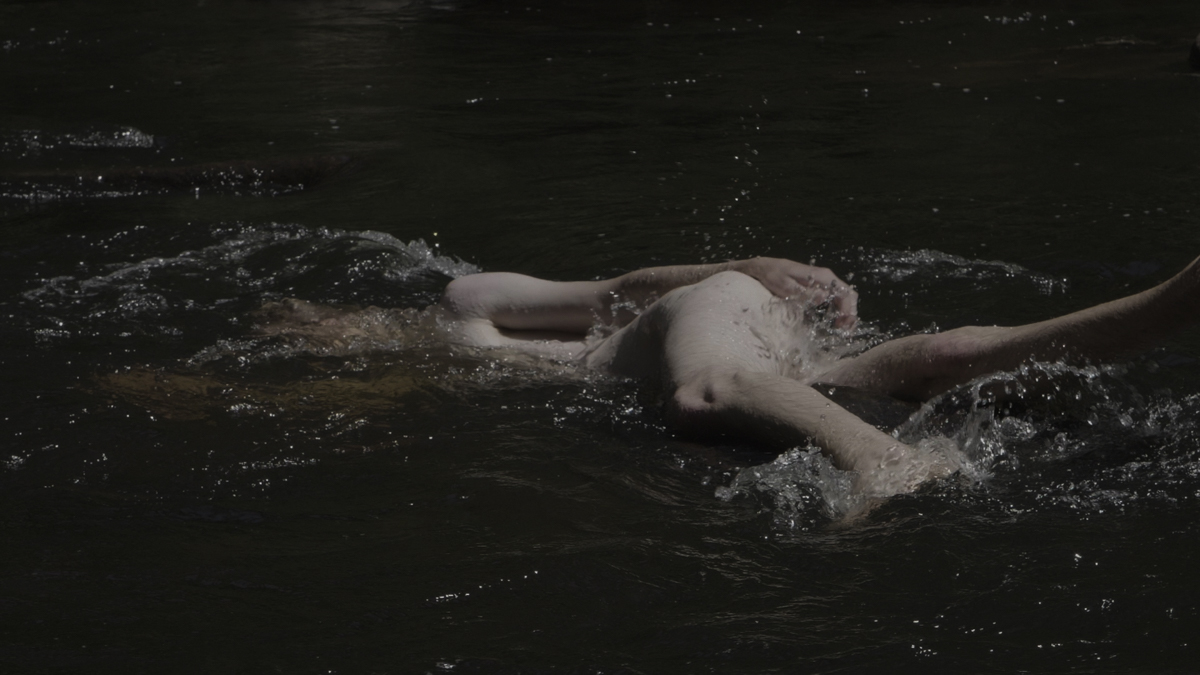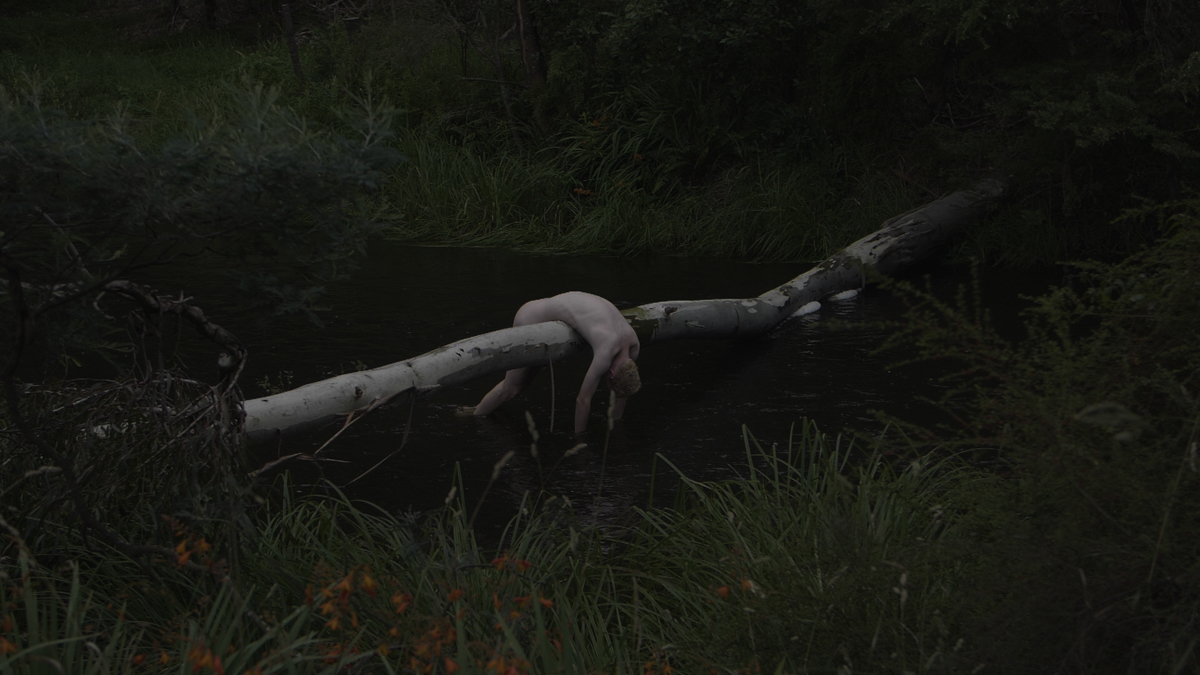'Embrace: A river runs through' / Walter Bakowski
Rivers hold the peculiar appeal of simultaneously evoking changeless continuity and continuous change. Walter Bakowski’s video work “Embrace: A River Runs Through” positions this duality in the context of queer identity; its malleability, fluidity, and profound connection to the spiritual self. The contact between body and body of water is a source of comfort and buoyancy, but also a reminder of the unknowable nature of both the unconscious self and the vast universe. To attempt to live without change and redefinition is to attempt to step into the same river twice.
Walter has exhibited at the Museum of Contemporary Art Australia, the Centre for Contemporary Photography and Seventh Gallery. Their work is also held in the public collection at the National Library of Australia. “Embrace: a river runs through” forms part of “Pearlescent Verse”, a screen-based exhibition curated by Jake Adam Treacy and initiated by Blindside Gallery. The works are unified by the common tributary of water, an element which extends its amorphous reach to issues ranging from climate change to migration and spirituality. A free (but ticketed!) screening and panel discussion with the artists takes place on Friday May 17th as part of the Human Rights Arts & Film Festival. In the lead-up to the event, we met with Walter to discuss spirituality, creative lineages and chaos witchcraft.
What place did spirituality have in your upbringing? Which elements of this upbringing did you retain, and which did you move away from?
I was raised in a very Catholic family- two of my aunts are nuns. For my mother in particular, spirituality has always been an important part of life and those core beliefs were passed onto me throughout my adolescence. As I grew older and became more autonomous in my beliefs I lost touch with the ritual side of spirituality, and it took time for me to rediscover the importance of belief and ritual practice on my own terms. I now have a huge appreciation for the power of belief and ritual, and make use of them in both my art practice and day to day life.
How does spirituality manifest itself in your day to day life?
I see the spiritual world and magick not as supernatural phenomena, but rather as ways of appreciating and re-examining aspects of our existence external and internal to our conscious selves. I think that, as people, this sense of oneness with both our environment and subconscious allows us to harness the power, beauty and truth of what we are.
Is this partly what drew you to chaos witchcraft? What is it?
Chaos magick is an occult technique that involves creating and borrowing from various magical systems and traditions, using belief as a tool. The idea of drawing significance from my own experiences deeply appealed to me- in contrast to my alienation with organised religion where, at least in the context of the Catholic doctrine, I found it very difficult to see myself as a queer person.
A lot of your work revolves around the process of “queering” spaces. What do you feel is represented by a “queer space”? How has this concept formed part of your practice?
To queer a space is to engage with the memories a space holds; to disrupt its presumed heteronormativity. It is an act of finding queer significance and perspective in the everyday, and reclaiming the space through resistance as well as connection, allowing a healing process to begin to form. I worked on a performance piece recently for Seventh Gallery which focused on engaging people with a queer body in the gallery space as research into the representation of peripheral bodies in the arts. The performance was designed to encourage an interaction between my queer body and that of the viewer. Through an act of endurance and ritual a healing process was able to form.
Your work, ‘Embrace: A River Runs Through’ has been described as a “queer baptism”. Was reclaiming the religious narrative in a queer context part of your aim?
For me, it was inevitable that these two important aspects of my life- queerness and religion- would intersect. Art allows me to form my own narratives and reclaim religious gestures and rituals associated with transcendence and transformation from a queer perspective.
Personally, I believe that transcendence comes from the land, not from manufactured structures. As an artist working on stolen land, I want to pay homage and engage with the spiritual power that these places hold to their traditional owners. While my baptism within this piece deals with queer transformation, it is also about understanding my place in the context of the deep histories of this land that I live and work on.
Speaking of histories and lineages, whose work inspires you to create?
The idea of lineages through blood, but more importantly through choice is very prevalent to queerness. Adopting a queer family of people who support and encourage one another has inspired me enormously and allowed me to cross paths with many incredible people. Two of my biggest art influences for ‘Embrace; A River Runs Through’ have been Ana Mendieta and Bill Viola. Both these artists explore the intersection between the human body and nature or the elements, and its potential to facilitate transcendence and transformation.
When do you feel most transcendent?
Often those moments come while I am performing for my work. I find a focus and attention that captivates my whole being and my art is often a documentation of such moments. This transcendence is facilitated through intention, research and ritual, but is also highly intuitive.
And lastly, what’re you working on at the moment?
I am currently exploring the narrative of the character of Ophelia as an anti-patriarchal and gender non-conforming figure within history. I’m particularly interested in the way in which this role has persisted through time, and has been reclaimed in many different contexts and by many different artists, such as Lizzie Siddal.
Thank you! We’re looking forward to the screening!
“Pearlescent Verse” features the work of Walter Bakowski as well as that of Tané Andrews, Léuli Eshraghi + Joe Joe Orangias, Nikki Lam, Blake Lawrence, Sean Miles, Lucie McIntosh, Angela Tiatia, Justine Youssef + Duha Ali and Manisha Anjali. It screens on Friday, May 17th 6.30pm - 8.30pm at Dancehouse Theatre, Carlton North, followed by a panel discussion with the artists. Book tickets here for this free event!
(some of the) Words: Ronlee Korren



